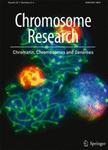版权所有:内蒙古大学图书馆 技术提供:维普资讯• 智图
内蒙古自治区呼和浩特市赛罕区大学西街235号 邮编: 010021

作者机构:St Petersburg State Univ St Petersburg Russia Inst Anim Physiol & Genet Libechov Czech Republic
出 版 物:《CHROMOSOME RESEARCH》 (Chromosome Res.)
年 卷 期:2025年第33卷第1期
页 面:1-19页
核心收录:
学科分类:0710[理学-生物学] 071010[理学-生物化学与分子生物学] 07[理学]
基 金:Academy of Sciences of the Czech Republic [RVO 67985904] MK-3553.2022.1.4
主 题:Centromere FISH-mapping Germinal vesicle Histone locus bodies Karyotype analysis Lampbrush chromosomes Non-coding RNA Oocyte nucleus Tandem repeats Telomere Zebrafish
摘 要:Danio rerio, commonly known as zebrafish, is an established model organism for the developmental and cell biology studies. Although significant progress has been made in the analysis of the D. rerio genome, cytogenetic studies face challenges due to the unclear identification of chromosomes. Here, we present a novel approach to the study of the D. rerio karyotype, focusing on the analysis of lampbrush chromosomes isolated from growing oocytes. Lampbrush chromosomes, existing during diplotene, serve as a powerful tool for high-resolution mapping and transcription analysis due to their profound decondensation and remarkable lateral loops decorated by RNA polymerases and ribonucleoprotein (RNP) matrix. In D. rerio, lampbrush chromosomes are about 20 times longer than corresponding metaphase chromosomes. We found that the lampbrush chromosome stage karyotype of D. rerio is generally undifferentiated, except for several bivalents bearing distinct marker structures, including loops with complex RNP matrix and locus-associated nuclear bodies. Locus-associated nuclear bodies were enriched for coilin and snRNAs;the loci where they formed presumably correspond to the histone gene clusters. Further, we observed the accumulation of splicing factors in giant terminal RNP aggregates on one bivalent. DAPI staining of Danio rerio lampbrush chromosomes revealed large and small chromomeres non-uniformly distributed along the axis. For example, D. rerio lampbrush chromosome 4, comprising the sex-determining region, is divided into two halves-with small chromomeres bearing long lateral loops and with large dense chromomeres bearing no or very tiny lateral loops. As centromeres were not distinguishable, we identified centromeric regions in all bivalents by FISH mapping of pericentromeric RFAL1, RFAL2, and RFAM tandem repeats. Through a combination of morphological analysis, immunostaining of marker structures, and centromere mapping, we developed cytological maps of D. rerio lampbrush c